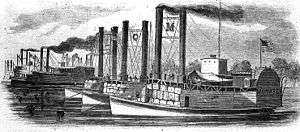USS Samson (1860)
 Ships in the foreground are: Monarch (letter "M" between stacks), Queen of the West (with letter "Q") and Lioness(letter "L"). In the left background are: Switzerland (with letter "S" on paddlebox), Samson and Lancaster are in the background. | |
| History | |
|---|---|
| Launched: | 1860, at California, Pennsylvania |
| In service: | 1862 |
| Out of service: | 1865 |
| Struck: | 1865 (est.) |
| Fate: | sold, 9 August 1865 |
| General characteristics | |
| Displacement: | 230 tons |
| Propulsion: |
|
| Armament: | ram |
.jpg)
USS Samson (1860) was a steamer acquired by the Union Army at the start of the American Civil War to serve with the ram fleet in the Mississippi River and its tributaries.
She was transferred to the Union Navy in 1862 who continued her service on the Mississippi River. She was used as a tugboat and as a ship’s tender which provided machine shop services to the ships in the fleet.
Civil War service
Under Union Army service
Samson, a wooden side wheel steamer built in 1860 at California, Pennsylvania, was purchased by the Union Army on 14 July 1862 for service in the Ellet ram fleet.
Service with the Union Navy
After the Western flotilla was placed under Navy command in the early autumn of 1862, Samson was transferred to the Union Navy on 27 November 1862. She served the Mississippi Squadron as a tugboat and a floating machine shop throughout the remainder of the Civil War. As such, she was one of the early predecessors of modern repair ships.
Post-war disposition and subsequent commercial career
After the end of hostilities, she was sold at public auction at Mound City, Illinois, to J. W. Clark and J. Nixon, et, al., on 9 August 1865. She was redocumented on 27 December 1865 and remained in merchant service until 1869.
See also
- Confederate States Navy
- Anaconda Plan
- Mississippi Marine Brigade
- United States Navy
- List of United States Navy ships
- Vicksburg Campaign
References
This article incorporates text from the public domain Dictionary of American Naval Fighting Ships. The entry can be found here.

